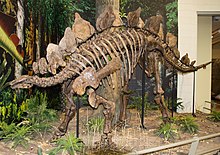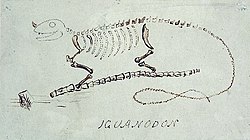Portal:Dinosaurs
IntroductionDinosaurs are a diverse group of reptiles of the clade Dinosauria. They first appeared during the Triassic period, between 243 and 233.23 million years ago (mya), although the exact origin and timing of the evolution of dinosaurs is a subject of active research. They became the dominant terrestrial vertebrates after the Triassic–Jurassic extinction event 201.3 mya and their dominance continued throughout the Jurassic and Cretaceous periods. The fossil record shows that birds are feathered dinosaurs, having evolved from earlier theropods during the Late Jurassic epoch, and are the only dinosaur lineage known to have survived the Cretaceous–Paleogene extinction event approximately 66 mya. Dinosaurs can therefore be divided into avian dinosaurs—birds—and the extinct non-avian dinosaurs, which are all dinosaurs other than birds. Dinosaurs are varied from taxonomic, morphological and ecological standpoints. Birds, at over 11,000 living species, are among the most diverse groups of vertebrates. Using fossil evidence, paleontologists have identified over 900 distinct genera and more than 1,000 different species of non-avian dinosaurs. Dinosaurs are represented on every continent by both extant species (birds) and fossil remains. Through the first half of the 20th century, before birds were recognized as dinosaurs, most of the scientific community believed dinosaurs to have been sluggish and cold-blooded. Most research conducted since the 1970s, however, has indicated that dinosaurs were active animals with elevated metabolisms and numerous adaptations for social interaction. Some were herbivorous, others carnivorous. Evidence suggests that all dinosaurs were egg-laying, and that nest-building was a trait shared by many dinosaurs, both avian and non-avian. (Full article...) Selected article
The Cretaceous–Paleogene extinction event, also known as either the K–Pg extinction event, Cretaceous–Tertiary extinction event, or K–T extinction event, was the large-scale mass extinction of animal and plant species in a geologically short period of time, approximately 66 million years ago (mya). The Cretaceous–Paleogene extinction event is associated with a geological signature, usually a thin band dated to that time and found in various parts of the world, known as the K–Pg boundary. K is the traditional abbreviation for the Cretaceous Period, Pg is the abbreviation for the Paleogene Epoch, and T is the abbreviation for the Tertiary Period. The event marks the end of the Mesozoic Era, and the beginning of the Cenozoic Era.
Non-avian dinosaur fossils are only found below the K–Pg boundary and became extinct immediately before or during the event. A very small number of dinosaur fossils have been found above the K-Pg boundary, but they have been explained as reworked, that is, fossils that have been eroded from their original locations then preserved in later sedimentary layers. Mosasaurs, plesiosaurs, pterosaurs and many species of plants and invertebrates also became extinct. Mammalian and bird clades passed through the boundary with few extinctions, and radiation from those Maastrichtian clades occurred well past the boundary. Rates of extinction and radiation varied across different clades of organisms. Many scientists theorize that the K-Pg extinctions were caused by one or more catastrophic geological events such as massive asteroid impacts or increased volcanic activity. Several impact craters and massive volcanic activity in the Deccan traps have been dated to the approximate time of the extinction event. These geological events may have reduced sunlight and hindered photosynthesis, leading to a massive disruption in Earth's ecology. Other researchers believe the extinction was more gradual, resulting from slower changes in sea level or climate. (see more...) TopicsSubcategoriesSelected image
Photo credit: Commons:User:Mgiganteus Did you know...
Things you can do
Proposed deletions
Peer reviews
Articles to be merged
Articles to be split
Related content
Associated WikimediaThe following Wikimedia Foundation sister projects provide more on this subject:
Discover Wikipedia using portals |





























